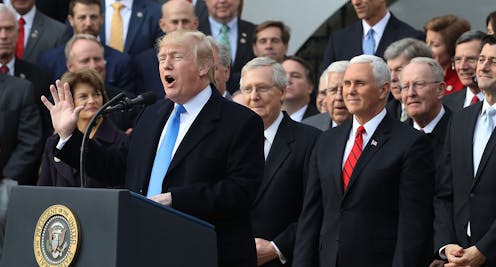
President Donald Trump, Vice President Mike Pence and Republican lawmakers celebrate the passage of the Tax Cuts and Jobs Act in December 2017. Chip Somodevilla/Getty Images
Americans give about half a trillion dollars a year to charity. That money helps fund services for the homeless, fight diseases, run museums and other organizations doing worthwhile activities. Some donations, such as those supporting religious congregations, are expenditures that the U.S. government couldn’t legally make even if it wanted to.
That helps explain why the U.S. tax code encourages giving by offering some donors a tax break. When those taxpayers give, they get a discount on their tax bill through the charitable deduction.
Overall, this deduction lowers tax revenue by tens of billions of dollars every year. To be sure, since giving is socially valuable, the forgone tax dollars might be worth it.
Many taxpayers stopped taking advantage of this tax break after President Donald Trump signed the Tax Cuts and Jobs Act into law in late 2017.
This law greatly increased the standard deduction. As a result, many people stopped itemizing and started using the standard deduction instead because they could pay less in taxes without itemizing that way.
About 30% of taxpayers itemized their tax returns in 2017, making them free to take advantage of the charitable deduction, according to the Internal Revenue Service. But since 2018, only about 10% have been itemizing.
For the 30 million taxpayers who stopped itemizing, the charitable deduction disappeared. They lost an incentive to support many of their favorite causes.
I am an economist who studies charitable activities and public policy. Working with two colleagues, Mark Ottoni-Wilhelm and Xiao Han, I co-authored a study looking at what happened to charitable giving after the Trump-era tax reforms were enacted.
Losing out on revenue
Our study uses data from the University of Michigan’s Panel Study of Income Dynamics, which asks families questions over time, to look at how their giving behavior changed when tax laws changed. This survey lets us see how donations from the same families changed after they stopped using the charitable deduction. This data is available every other year. We studied what happened in 2018, compared with 2016.
We found that Americans who stopped itemizing their tax deductions gave less to charity in 2018 than they otherwise would have. On average, these donors who could use the charitable deduction in 2016 gave nearly US$1,000 less in 2018 after losing out on the tax break.
All told, we estimate that the 2017 tax package annually reduced charitable giving from individual donors by about $20 billion in the following year from what we would have seen had the bill not become law. That’s roughly 5% of all charitable giving.
Overall, charitable giving fell to $523 billion in 2018 from $528 billion a year earlier, measured in inflation-adjusted 2023 dollars, according to the annual report from the Giving USA Foundation, produced in partnership with the Indiana University Lilly Family School of Philanthropy. It fell again in 2019, then rose in 2020 and 2021 before declining in 2022 and 2023, when giving stood at $557 billion.
Giving from individual donors, after the same kinds of fluctuations, had declined by $2 billion to $374.4 billion in 2023 from $376.4 billion six years earlier, in 2017. Giving by foundations and corporations rose over those same six years. Bequests from the estates of people who had died fell – a reflection of effects from other changes in the Tax Cuts and Jobs Act.
To be clear, giving usually increases from year to year – especially when the economy is doing well, as it has generally fared in recent years. Had the tax laws not changed, we would have expected an increase in giving, especially from individual donors, after 2017.
New opportunity to encourage giving through the tax code
The charitable deduction encourages giving but costs the government money in terms of lost tax revenue. Economists and policymakers have long wondered whether the trade-off makes sense. We believe that our study offers clear evidence that the tax code can promote charitable giving.
Congress will get a new opportunity to expand tax incentives for charitable giving in 2025, before many Tax Cuts and Jobs Act provisions expire in 2026.
Some lawmakers are already trying to increase giving incentives for the donors who don’t itemize their tax returns. But it’s not clear that they will prevail once this debate heats up.
The collection of the data used for this study was partly supported by the National Institutes of Health (R01 HD069609, R01 AG040213); and the National Science Foundation (SES 1157698, 1623684). Collection of the Philanthropy Panel Study data within the PSID was begun in 2001 with funding from the Atlantic Philanthropies, with continuing waves funded by partnering donors; recent institutional donors include the Bill & Melinda Gates Foundation, Charles Stewart Mott Foundation, Fidelity Charitable Catalyst Fund, Google.org Charitable Giving Fund and The John Templeton Foundation.
Advertisement

Advertisement
Contact Us
If you would like to place dofollow backlinks in our website or paid content reach out to info@qhubonews.com











